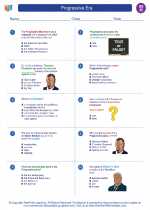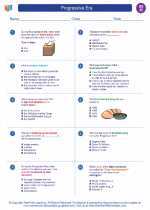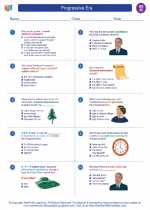Progressive Era
One of the biggest reform goals was the process in which government officials were elected. This, along with the need for government involvement in reform, were two of the motivating factors for people such as Eugene Debs, Susan B. Anthony and W.E.B. DuBois to become leaders during the Progressive Era. Read More...
◂Social Studies Worksheets and Study Guides Eighth Grade. Progressive Era
Study Guide Progressive Era
Progressive Era  Worksheet/Answer key
Worksheet/Answer key Progressive Era
Progressive Era  Worksheet/Answer key
Worksheet/Answer key Progressive Era
Progressive Era  Worksheet/Answer key
Worksheet/Answer key Progressive Era
Progressive Era 

 Worksheet/Answer key
Worksheet/Answer key
 Worksheet/Answer key
Worksheet/Answer key
 Worksheet/Answer key
Worksheet/Answer key

The resources above cover the following skills:
National Standards for Civics and Government (NSCG)
How does the government established by the constitution embody the purposes, values, and principles of American democracy? How does the American political system provide for choice and opportunities for participation?
Political parties, campaigns, and elections. Students should be able to explain how political parties, campaigns, and elections provide opportunities for citizens to participate in the political process. To achieve this standard, students should be able to
Describe the role of political parties
What are the roles of the citizen in American democracy? How can citizens take part in civic life?
Forms of political participation. Students should be able to describe the means by which Americans can monitor and influence politics and government. To achieve this standard, students should be able to
Explain how Americans can use the following means to monitor and influence politics and government at local, state, and national levels
Joining political parties, interest groups, and other organizations that attempt to influence public policy and elections
Political leadership and public service. Students should be able to explain the importance of political leadership and public service in a constitutional democracy. To achieve this standard, students should be able to
Evaluate the role of ''the loyal opposition'' in a constitutional democracy
National Center for History in Schools (NCHS)
Historical Thinking Standards
Historical Comprehension
Reconstruct the literal meaning of a historical passage.
United States History Content Standards
Era 6: The Development of the Industrial United States (1870-1900)
Massive immigration after 1870 and how new social patterns, conflicts, and ideas of national unity developed amid growing cultural diversity.
The student understands how new cultural movements at different social levels affected American life.
Era 7: The Emergence of Modern America (1890-1930)
How Progressives and others addressed problems of industrial capitalism, urbanization, and political corruption.
The student understands the origin of the Progressives and the coalitions they formed to deal with issues at the local and state levels.
The student understands Progressivism at the national level.
The student understands the limitations of Progressivism and the alternatives offered by various groups.